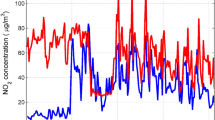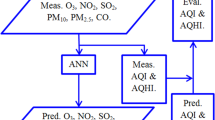Abstract
Urban air pollution is the most serious environmental pollution problem in China. It not only causes serious losses to our economy, but also brings great hidden dangers to the physical and mental health of urban residents. Therefore, it is urgent to prevent and control air pollution. Air quality prediction and forecasting must be carried out to prevent air pollution. Timely and accurate air quality prediction can not only help urban managers to make scientific and effective preventive measures, but also provide more healthy and safe travel strategies for urban residents. China’s air monitoring system is gradually improving, its scale is expanding, and a large amount of air quality data is accumulating. With the rapid expansion of data scale, the traditional method of air quality prediction technology has been unable to deal with these massive data. In this paper, 365 sets of air pollutant data from January 1, 2018 to December 31, 2018 in Shen Zhen were used as experimental objects. The improved SAPSO algorithm and PSO algorithm were used to optimize the parameters of SVM model and construct the air quality evaluation model. By analyzing the classification results of air quality grade, selecting relevant data and using partial least squares, the correlation coefficient matrix is established for the classification results, and the pollutant factors affecting air quality in Shenzhen are obtained. The results are ideal, which provides a scientific theoretical basis for the prevention and control of air pollution and urban management planning.









Similar content being viewed by others
Explore related subjects
Discover the latest articles, news and stories from top researchers in related subjects.References
Wang Y, Ge X-L, Liu J-L, Ding Z (2016) Study and analysis of energy consumption and energy-related carbon emission of industrial in Tianjin, China. Energ. Strat. Rev. 10:18–28
Li S, Zhou C, Wang S, Hu J (2018) Dose urban landscape pattern affect CO2 emission efficiency? Empirical evidence from megacities in China. J Clean Prod 203:164–178
Tan S, Yang J, Yan J, Lee C, Hashim H, Chen B (2017) A holistic low carbon city indicator framework for sustainable development. Appl Energy 185:1919–1930
Yan J, Chen B, Wennersten R, Campana P, Yang J (2017) Cleaner energy for transition of cleaner city. Appl Energy 196:97–99
Xi X, Wei Z, Xiaoguang R, et al (2016) A comprehensive evaluation of air pollution prediction improvement by a machine learning method. In: IEEE international conference on service operations & logistics. IEEE
Das TK (2016) A customer classification prediction model based on machine learning techniques. In: International conference on applied and theoretical computing and communication technology. IEEE
Li J, Chen Q, Liu B (2017) Classification and disease probability prediction via machine learning programming based on multi-GPU cluster MapReduce system. Kluwer Academic Publishers, Dordrecht
Liu X, Li Y, Liu D et al (2017) An Adaptive CU Size Decision Algorithm for HEVC Intra Prediction based on Complexity Classification using Machine Learning. IEEE Trans Circuits Syst Video Technol 29:144
Pham BT, Prakash I, Bui DT (2018) Spatial prediction of landslides using a hybrid machine learning approach based on random subspace and classification and regression trees. Geomorphology 303:256
Zhang Y, Wen J, Yang G et al (2018) Air-to-air path loss prediction based on machine learning methods in urban environments. Wirel Commun Mobile Comput 2018:1–9
Norhayati I, Rashid M (2018) Adaptive neuro-fuzzy prediction of carbon monoxide emission from a clinical waste incineration plant. Neural Comput Appl 30(10):3049–3061
Liu W, Luo X, Xuan J, Xu Z, Jiang D (2016) Cognitive memory-inspired sentence ordering model. Knowl-Based Syst 104:1–13
Casas P, Seufert M, Wehner N, et al (2018) Enhancing machine learning based QoE prediction by ensemble models. In: 2018 IEEE 38th international conference on distributed computing systems (ICDCS). IEEE
Alharbi AR, Thornton MA (2016) Demographic group prediction based on smart device user recognition gestures. In: 2016 15th IEEE international conference on machine learning and applications (ICMLA). IEEE
Malhotra R (2015) A systematic review of machine learning techniques for software fault prediction. Appl Soft Comput 27:504–518
Gao C, Sun H, Wang T et al (2018) Model-based and model-free machine learning techniques for diagnostic prediction and classification of clinical outcomes in Parkinson’s Disease. Sci Rep 8(1):7129
Mohammadi P, Wang ZJ (2016) Machine learning for quality prediction in abrasion-resistant material manufacturing process. In: Electrical & Computer Engineering. IEEE
Le DH, Hoai NX, Kwon YK (2015) A Comparative study of classification-based machine learning methods for novel disease gene prediction. In: KSE 2014
Reid CE, Jerrett M, Petersen ML et al (2015) Spatiotemporal prediction of fine particulate matter during the 2008 Northern California wildfires using machine learning. Environ Sci Technol 49(6):3887–3896
Mohabatkar H, Mousavizadegan M (2016) An evaluation on different machine learning algorithms for classification and prediction of antifungal peptides. Med Chem 12(8):1563–1571
Wang Q, Jianbin WU, Lin Y (2015) Implementation of a dynamic linear regression method on the CMAQ forecast of PM_(2.5) in Shanghai. Acta Sci Circumst 35(6):1651–1656
Zaouali K, Ammari M L, Bouallegue R, et al (2016) Incoming data prediction in smart home environment with HMM-based machine learning. In: 2016 International symposium on signal, image, video and communications (ISIVC). IEEE
Bell D (1974) The coming of post-industrial society Colophon Books. Harper, New York
Acknowledgements
This research/work was supported by the National Natural Science Foundation of China (NSFC) No. 71463056, The “silk road” scientific research and innovation Project, No. JGSL18004, Science and technology innovation program for doctoral students of Xinjiang University, No. XJUBSCX-201920, joint Foundation for the NSFC and Guangdong Science Center for Big Data No. U1611261, University scientific research program of Xinjiang Uygur autonomous region, No. XJEDU2019SY005.
Author information
Authors and Affiliations
Corresponding author
Ethics declarations
Conflict of interest
The authors declare that they have are no conflict of interest.
Additional information
Publisher's Note
Springer Nature remains neutral with regard to jurisdictional claims in published maps and institutional affiliations.
Rights and permissions
About this article
Cite this article
Gu, K., Zhou, Y., Sun, H. et al. Prediction of air quality in Shenzhen based on neural network algorithm. Neural Comput & Applic 32, 1879–1892 (2020). https://doi.org/10.1007/s00521-019-04492-3
Received:
Accepted:
Published:
Issue Date:
DOI: https://doi.org/10.1007/s00521-019-04492-3




